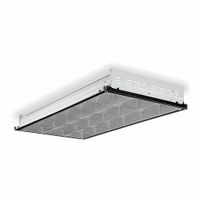- Home
- Lighting
- Lighting Fixtures Retrofit Kits
- Panel Troffer Light Fixtures
- Fluorescent Troffers
Fluorescent Troffers
Fluorescent troffers mount in drop ceiling grids to supply a large amount of light for spaces such as offices, classrooms, retail settings, and hallways. They are recessed fixtures that keep most of the fixture concealed in the ceiling to provide a clean look that doesn't draw attention to the fixtu .....Read More
Frequently Asked Questions
What is a fluorescent troffer?
How do you install a fluorescent troffer in a drop ceiling?
What size fluorescent tubes do troffers use?
How do you choose the right color temperature for fluorescent troffers?
What are the benefits of using fluorescent troffers in commercial spaces?
How do you replace the bulbs in a fluorescent troffer?
What is the difference between recessed and surface-mounted troffers?
